Census data released today tell us the exact numbers of married, cohabiting and lone parent families in England & Wales in 2021. My analysis shows that of the 7.0 million households with dependent children under the age of 18, 55.9% were headed by a married couple, 17.3% by a cohabiting couple, and 26.9% by a lone parent. These figures include civil partnerships and same sex families.
Despite the trend away from marriage, these data show that 76% of couples with children are married, rising from 69% among parents of a 0-4 year old to 85% of parents of a 16-18 year old.

However these proportions contrast with estimates produced a year ago in the annual Families & Households report produced by the Office for National Statistics (ONS). Their 2021 figures show that 62.7% of families with dependent children were married, 14.4% cohabiting and 22.9% lone parents. (Although these data are for the UK as a whole, England & Wales account for 86% of UK households and so the proportions are directly comparable).
ONS plans to release the next batch of 2022 Families & Households data on 10 May. At that stage I expect they will show a significant retrospective adjustment to data for 2021 and previous years to account for the new Census figures.
Based on these Census proportions, I calculate that they have overestimated the number of married families in 2021 by 550,000 (+12%) and underestimated the number of cohabiting families by 230,000 (-16%) and lone parent families by 320,000 (-15%).

What this shows is the importance of the Census as a benchmark. Every time anyone runs a survey, the results have to be ‘weighted’ in order to try and represent the population as a whole. So if 70% of those who complete a survey are women, for example, those results must be ‘weighted’ to reflect the reality that 50% of the population are women. The only way we know this for sure is through the Census conducted every ten years. The further away from the Census we get, the bigger the potential for uncertainty in population estimates.
The Families & Households survey is based on 41,000 households who complete the Labour Force Survey. Their results can now be adjusted retrospectively to reflect the real population.

